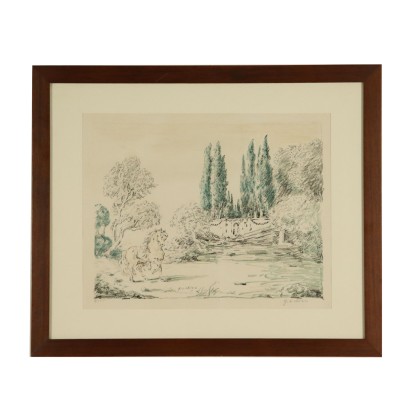Color Lithography by Giorgio De Chirico Horse in the Landscape - Horse in the landscape
Features
Artist: Giorgio De Chirico (1888-1978)
Artwork title: Cavallo nel paesaggio
Age: 20th Century / 1901 - 2000
Subject: Landscape with Figures
Artistic technique: Printing
Technical specification: Lithography
Description : Cavallo nel paesaggio
A color lithography by Giorgio De Chirico (1888-1978). Signed in form and with pencil at the bottom right. Series number 72/125. Sign of light folding in the middle. In frame.
Product Condition:
Good condition. Wear consistent with age and use. Any damage or loss is displayed as completely as possible in the pictures.
Frame Size (cm):
Height: 55
Width: 66
Depth: 2
Artwork dimensions (cm):
Height: 37
Width: 47
Additional Information
Artist: Giorgio De Chirico (1888-1978)
Born in Volos (Greece) in 1888, son of a railway engineer, Giorgio De Chirico first lived in Athens, where he studied at the local polytechnic, then, in 1905, he moved with his mother and brother Andrea (known under the pseudonym Alberto Savinio) in Munich, where in 1906 he began to work in the city academy under Klinger. Deeply impressed by the art of A. Böcklin and the philosophy of Nietzsche, he began to paint allegorical pictures. In 910 he made a trip to Florence, where he painted the Enigma of the oracle and the Enigma of an autumn afternoon, the first works in which the symbolic possibilities of dreams are revealed, in which real objects find themselves in unnatural relationships and unusual, set within a suspended atmosphere. From 1911 to 1915 he was in Paris, where he met Apollinaire, Jacob, Picasso. Back in Italy, where he did his military service during the war, De Chirico became with Carlo Carrà the initiator of "metaphysical" painting, aimed at creating fantastic suggestions with the juxtaposition of disparate objects and especially ancient statues in a space built according to the rules of fifteenth-century perspective, but lit by decidedly modern colours, with astonishing associations not only of senses and ideas, but also of history and time. In 1925 he returned briefly to Paris, at the dawn of surrealism; but he had already oriented himself, in various decorations of Roman villas, towards an openly romantic painting, abandoning the severe rigor of "metaphysical" painting. He then moved on to recalling classical motifs (horses by the sea, gladiators, etc.); he then turned to a seventeenth-century inspired realism of effect. There are also numerous self-portraits, in which De Chirico represents himself through celebratory or deliberately ironic paintings. The love for metaphysical painting once again asserted itself in his last works, confirming De Chirico's desire to reveal the mystery of existence through the fascination of his paintings. Giorgio De Chirico was also a set designer, he wrote a novel (Hebdomeros, 1930) and an autobiography (1945). In recent times he had taken a polemical stance against contemporary art. De Chirico died in Rome in 1978.
Age: 20th Century / 1901 - 2000
20th Century / 1901 - 2000
Subject: Landscape with Figures
Artistic technique: Printing
La stampa è un processo per la produzione di testi e immagini, tipicamente mediante l'impiego dell'inchiostro su carta e di una pressa da stampa. Spesso viene svolto come processo industriale su larga scala ed è una parte essenziale dell'editoria.
Technical specification: Lithography
Lithography is a technique of mechanical reproduction of images. The procedure was invented in 1796 by the German Alois Senefelder using a stone of the quarries of barbecuing and leisure activities, a small town close to Munich. Initially called "chemical printing on stone", and assumed very soon the name of "lithographic art" or, more simply, of lithography. 






















